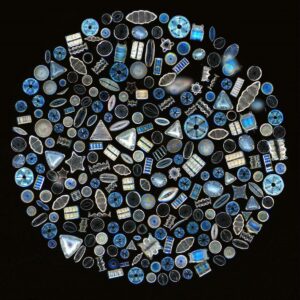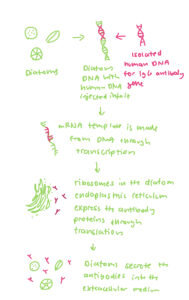
Besides appearing like a lovely spread for an I Spy book, the above image holds many scientific secrets and perhaps solutions. Diatoms, known as “jewels of the sea,” are a type of single-celled phytoplankton (aka algae) that create their own glass shell and produce at least 20% of Earth’s atmospheric oxygen. And perhaps, they can contribute to the treatment of many different diseases, including cancer.
As promising specimens of microalgae, they have been co-opted by the biotech industry for their ability to make complex lipids, sugars, and even proteins through a process called recombinant production. Traditionally, these molecules are made through classical systems such as yeasts, bacteria, and other single-celled organisms that are easy to manipulate in a lab. Microalgae, a more recent biotech specimen, is more efficient because it can produce its own energy from sunlight and air alone through photosynthesis, whereas other cells must be fed carbon. Thus, algae propose the possibility of a solar-powered system that can manufacture specific proteins with high efficiency. In 2012, microbiologists Franziska Hempel and Uwe G Maier modified the diatom P. tricornutum through recombinant production to make IgG antibodies, a protein that immune cells use to fight foreign pathogens in the blood.

To understand how recombinant production works, we’ll look at the central dogma of molecular biology—a name both dramatic and apt. In short, the central dogma states that proteins are made in cells through the flow of information from DNA to a protein. DNA, the keeper of all protein “instructions,” is copied into RNA, the messenger which carries this information to ribosomes, the actual protein “factories.” From here, ribosomes translate the information in the RNA into the form of protein. After this, the protein is modified (post-translational modifications) to be sent off or used within the cell. This entire process—DNA information being transformed into proteins—is called gene expression.
Because proteins are made from whatever information is in DNA, biotechnologists discovered that by altering DNA, you can also alter the proteins created. In recombinant production, foreign DNA (DNA from another cell) is inserted into a host cell’s DNA (the cell that is making the protein). Through the central dogma, this results in the expression of genes from the foreign DNA to make specific proteins. In the diatom-antibody experiment, Hempel and Maier injected the human DNA for making CL4mAb IgG antibodies (a type of protein used by the immune system) into diatom DNA, so that human DNA will be expressed into IgG antibodies by the diatom. You can think of DNA as the instructions to make the antibodies, and the diatom as the machine. Once new protein instructions are injected into the machine’s existing instructions, the machine will begin to create the new proteins based on the instructions. The kind of protein produced depends on the specific instructions, on the specific segments of foreign DNA inserted into the diatom’s DNA.
In using diatoms to make recombinant proteins, Hempel and Maier made five promising discoveries:
1) The diatom P. tricornutum very efficiently produces antibodies, accounting for a significant 9% (efficient in the biotech world) of total soluble protein.
2) It secretes antibodies directly into the extracellular medium . This is a big economic advantage because the cells don’t need to be lysed (broken) to harvest the product.
3) Diatoms don’t naturally secrete many proteins, so the secreted antibodies are already very pure.
4) The antibodies are fully assembled and functional. In fact, the diatom has mechanisms to guarantee that only fully assembled antibodies can leave the cell . This makes it act virtually like a human plasma cell, an immune cell that secretes antibodies. This ability is absent in other recombinant producing species, such as bacteria.
5) The antibodies are stable for at least 2 days. When the diatoms become unproductive, they can easily be stimulated again when the culture medium is replaced.
Due to these findings, diatoms and other species of microalgae on the whole present great economic and scientific potential for making antibodies as well as other proteins. When tested against the Hepatitis B virus, the IgG antibodies were proven functional.
Why would scientists want to make antibodies anyway? In the naturally functioning human body, antibodies are proteins secreted by plasma cells that bind to antigens (specific protein receptors) on the surface of germs and other harmful foreign cells, rendering them harmless. Laboratory-made antibodies—such as the antibodies created by diatoms—are also known as monoclonal antibodies (mAbs) and have similar applications. In Hempel and Maier’s study, specific IgG antibodies were made to target the Hepatitis B virus. In other instances, mAB shape can be modified to bind to certain targets, such as antigens on cancer cells, viruses, and other bacteria. Because antibodies are proteins that bind to receptors unique to specific cells, they are also used to locate certain cells. For example, monoclonal antibodies are used in identifying where there is cancer in the body and even in carrying drugs to cancer cells.
Thus, the efficiency of monoclonal antibody production, as demonstrated in the diatom experiment, is key in treating specific ailments on a microscopic level. Currently, mammal cells are used for 60-70% of recombinant pharmaceuticals, but cultivation is expensive (due to having to feed them) and there’s always the risk of pathogenic contamination. Algae, if modified to be as efficient as mammalian cells, may prove to be a more economically and sustainably suitable alternative. They perform very well in producing recombinant proteins, without needing to be fed. Additionally, any aquarium owner knows that they grow at rapid rates.
It is no secret that global cancer rates have been on the rise. These growing biotechnological methods allows scientists to creatively explore different possibilities of treatment, from nanotechnology to photodynamic therapy, to our beloved monoclonal antibodies. Solutions may be found everywhere, from the tiniest protons to the inconspicuous jewel of the sea. And so the search continues!
Sources
Hempel, F., & Maier, U. G. (2012, September 13). An engineered diatom acting like a plasma cell secreting human IGG antibodies with high efficiency – microbial cell factories. BioMed Central. https://microbialcellfactories.biomedcentral.com/articles/10.1186/1475-2859-11-126
NCI Dictionary of Cancer terms. Comprehensive Cancer Information – NCI. (n.d.). https://www.cancer.gov/publications/dictionaries/cancer-terms/def/monoclonal-antibody